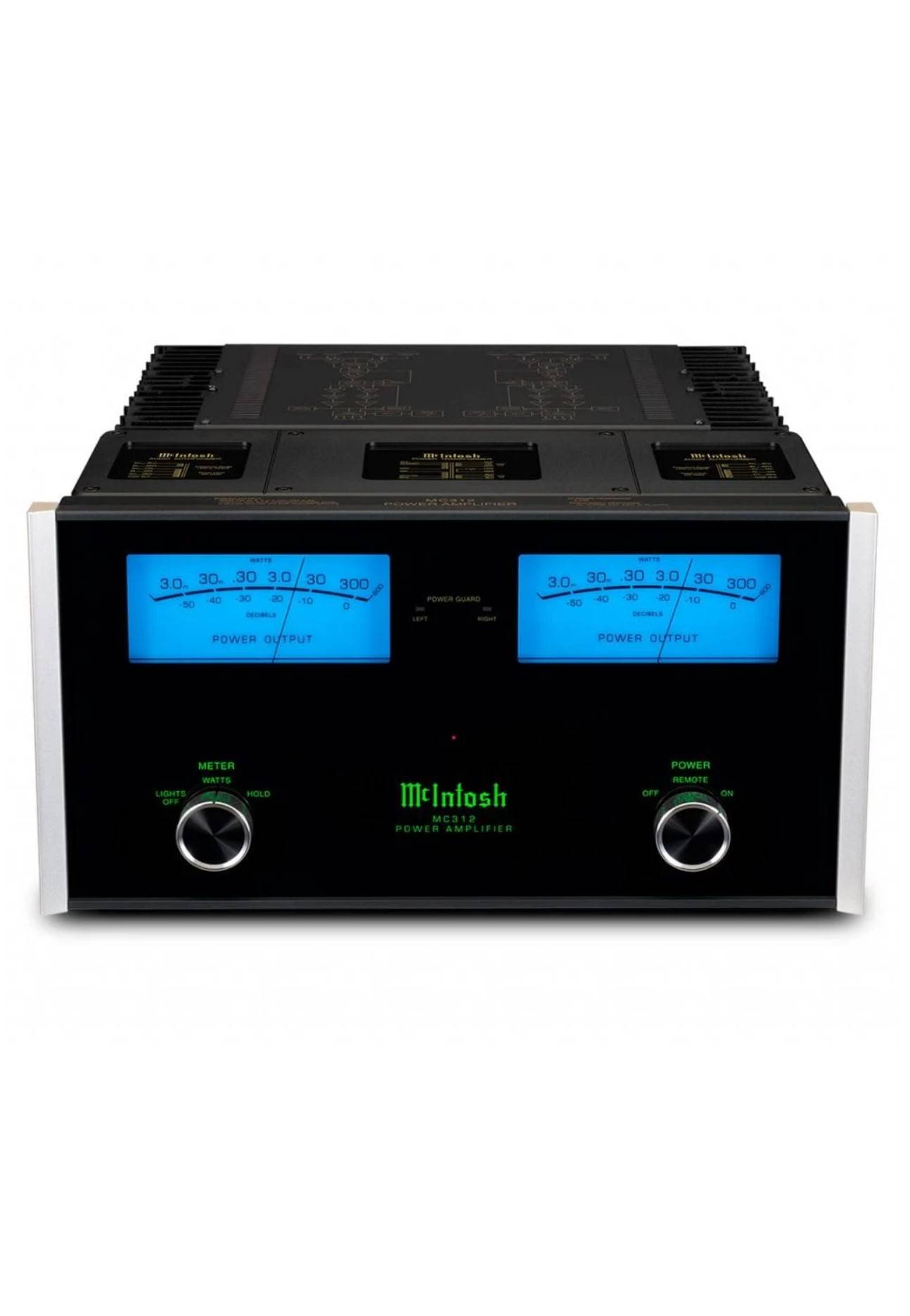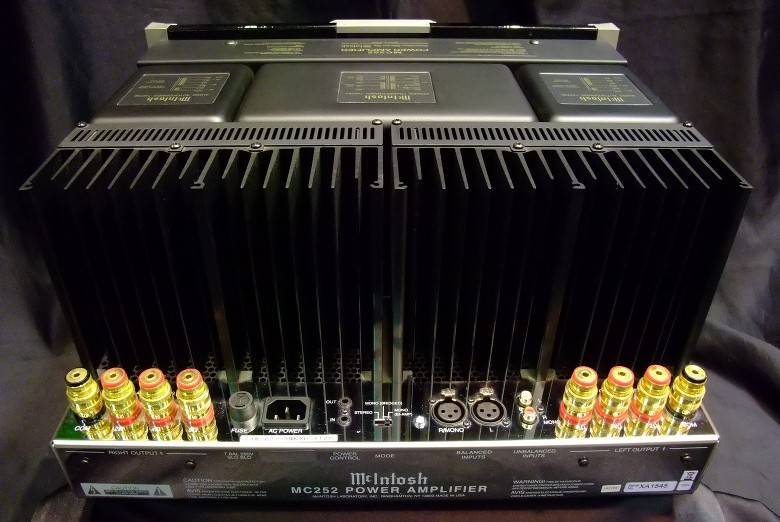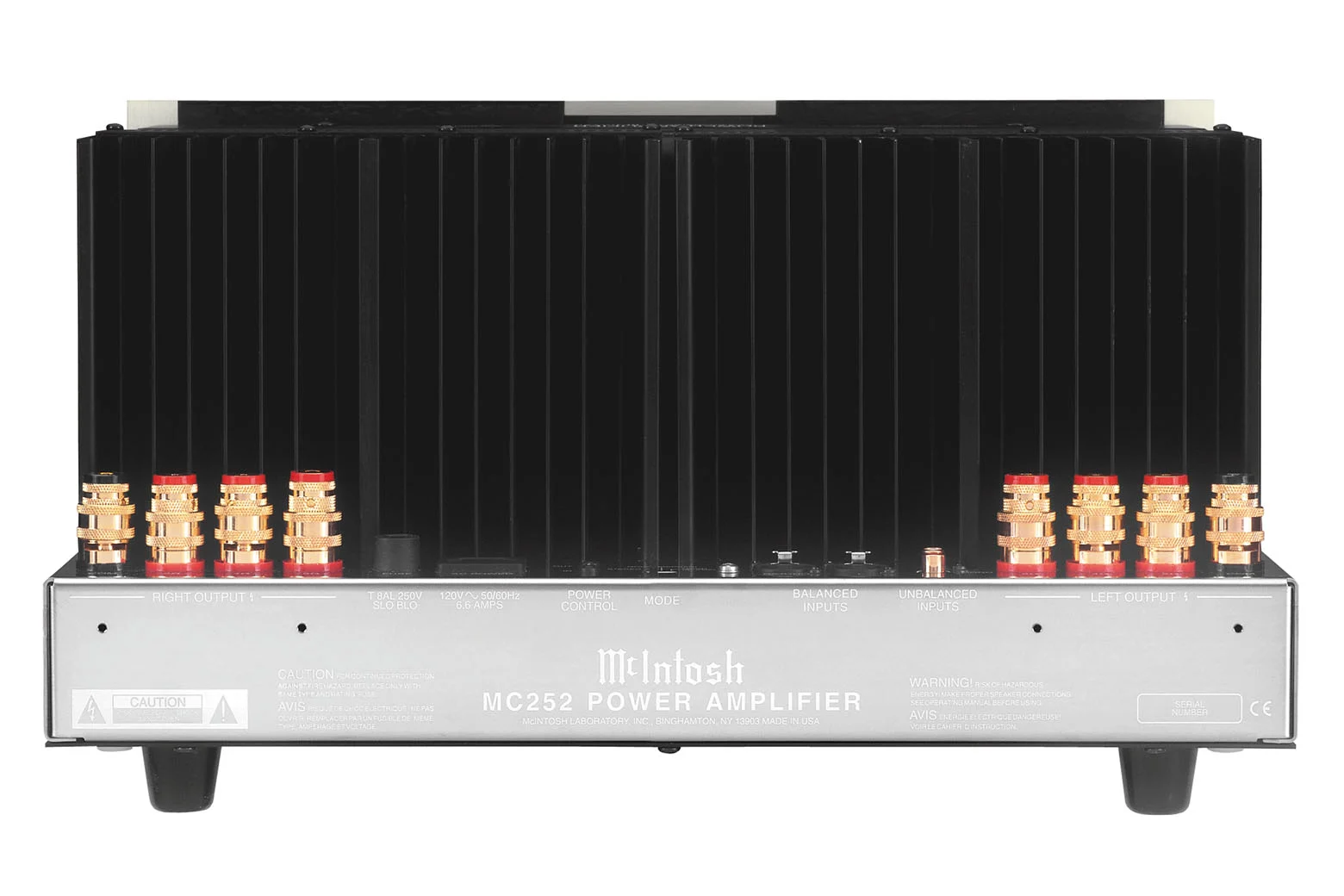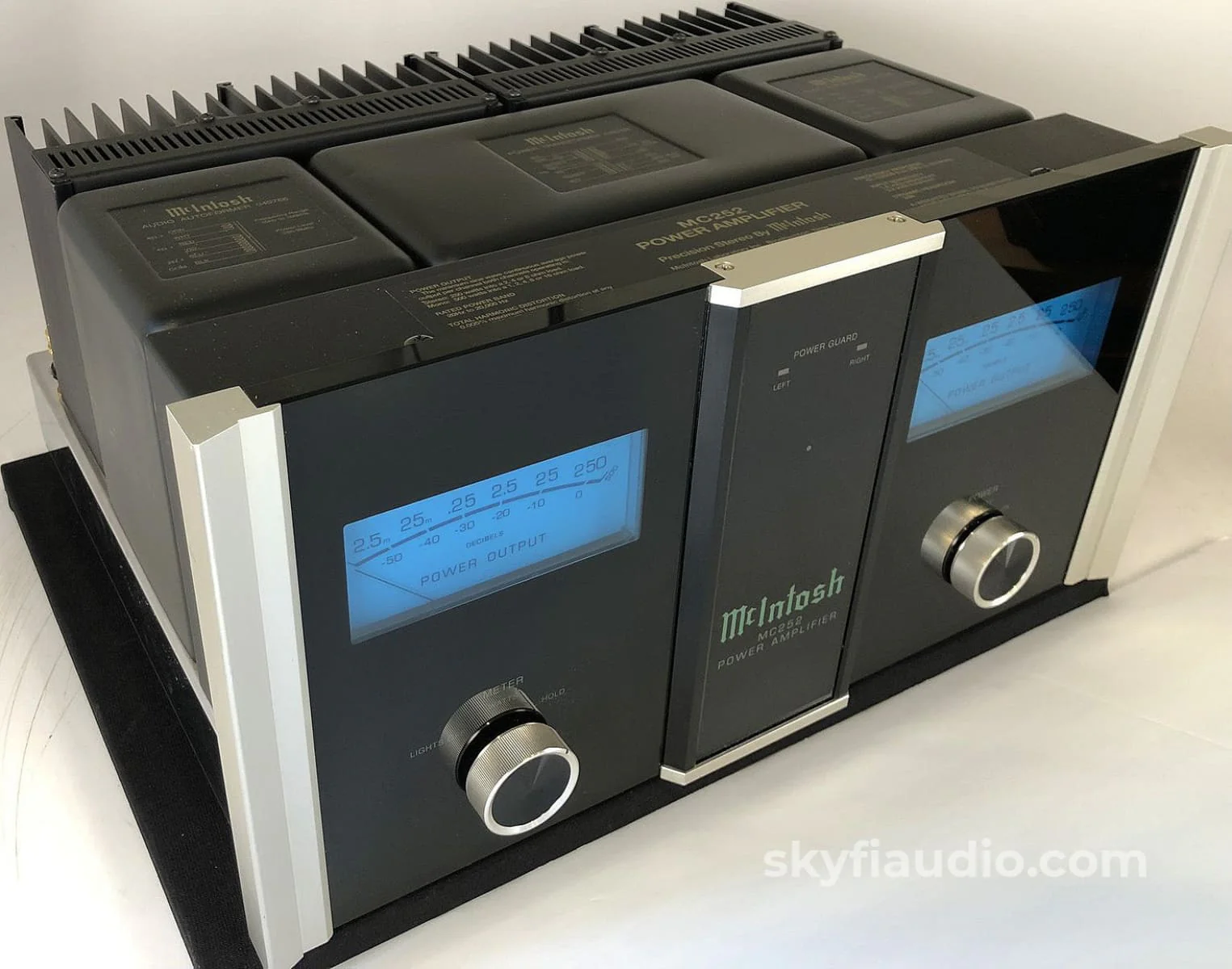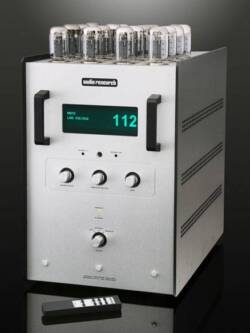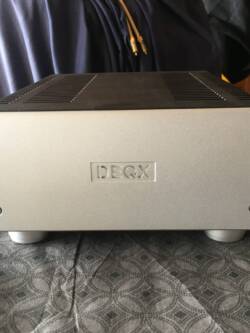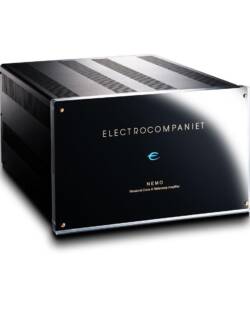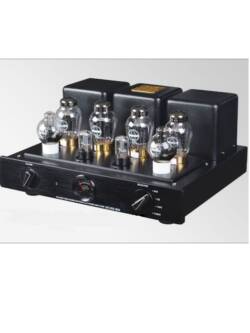McIntosh MC252 Power Amplifier 250W x 2
Original price was: R175,000.00.R62,000.00Current price is: R62,000.00.
The shallow depth of the MC252 makes it a snap to install in popular standard size
cabinets or shelving. With 250 watts per channel at 0.005% maximum distortion across
the entire audio spectrum, the MC252 delivers lots of clean power. The two channels
of the MC252 can also be combined into a single high-power channel that delivers 500
watts into 1, 2, 4, 8 or 16 Ohms.
McIntosh’s exclusive Output Autoformers® ensure that the amplifier will always deliver
full power, without stress, to any type of loudspeaker. Whether your speakers are 2, 4, or 8
Ohms, McIntosh autoformers ensure that you’ll always get all of the power you paid for.
The MC252 incorporates Power Guard®, a patented circuit design exclusive to McIntosh.
Power Guard monitors output power and prevents clipping dynamically using photo-optic
circuits. Protection at the speed of light.
RMS POWER OUTPUT
250W min. (stereo) or 500W min. (mono and biamp parallel) sine wave continuous average power
output from 20Hz to 20kHz.
RATED POWER BAND
20Hz to 20kHz
TOTAL HARMONIC DISTORTION
Maximum Total Harmonic Distortion at any power
level from 250 milliwatts to rated power output is
0.005%.
DYNAMIC HEADROOM
2.0dB
FREQUENCY RESPONSE
20Hz to 20kHz, +0 / -0.25dB
10Hz to 100kHz, +0 / -3dB
INPUT SENSITIVITY
1.6V unbalanced 3.2V balanced
A-WEIGHTED SIGNAL-TO-NOISE RATIO
112dB below rated output
INTERMODULATION DISTORTION
Maximum Intermodulation Distortion if instantaneous peak output per channel does not exceed
twice the rated output, for any combination of
frequencies from 20Hz to 20,000Hz, with all
channels operating is 0.005%.
INPUT IMPEDANCE
10,000 Ohms (unbalanced)
20,000 Ohms (balanced)
OUTPUT LOAD IMPEDANCE
Terminals for 2, 4, or 8 Ohms (stereo)
Terminals for 4, 8, or 16 Ohms (mono)
Terminals for 1, 2, or 4 Ohms (bi-amp parallel)
WIDE BAND DAMPING FACTOR
Greater than 40
POWER GUARD
Clipping is prevented and THD does not
exceed 2% with up to 14dB overdrive at 1kHz.
POWER REQUIREMENTS
120V, 50/60Hz, 6.6A
OVERALL DIMENSIONS
(H x W x D including feet and knobs)
9-7/16” (23.97cm) x 17-1/2” (44.45cm) x
14-13/16” (37.62cm)
WEIGHT
94-1/2 lbs. (42.87kg) net
108-1/2 lbs. (49.22kg) boxed
ADDITIONAL SPECIFICATION
DC Failure Protection
Thermal Sensors
Turn-on Delay
Soft Start Inrush Protection
Balanced and Unbalanced Inputs
Remote Power Control
Massive Gold Plated Output Binding Posts
Stainless Steel Chassis w/ Super Mirror Finish
Description
Until very recently, I never gave much thought to McIntosh equipment. I always thought that it looked beautiful but I believed it was overpriced and not a great value (a high-end version of Bose) – the kind of equipment that rich doctors and lawyers that don’t know, and don’t want to know, much about audio would buy. A few weeks ago, however, I happened to be in an audio store and heard a C46 pre-amp combined with an MC352 power-amp driving a pair of B&W 801s (I am not sure about the model but it listed for $12K). It was playing a CD I was very familiar with and it stopped me in my tracks. Having been in this hobby for a number of years I’ve heard a lot of nice systems but never one that sounded “sweeter” or more seductive. It had the right amount of warmth and detail. On that day I decided to learn more about McIntosh. Over the next few weeks I used the Internet to learn more about this brand. The more I read, the more I realized that McIntosh is a very polarizing brand. It has rabid fans but equally rabid detractors. I experimented with some vintage (70s and 80s) Mc gear and it sounded good – very good – but it was not the sound I heard at the store. I wanted the sound of the new McIntosh.
I visited a couple of different stores that sold McIntosh to do some more listening and to make sure that my first experience was not a fluke. I brought my familiar CDs (unfortunately no stores had a turntable set-up for auditions) and listened … and listened. I listened through speakers and headphones. I listened loud and soft. I listened to classical, jazz, and rock. Unlike many of the other brands the McIntosh equipment sounded delicious on everything. I know delicious is a strange term for an audio review, but sweet, silky, and delicious are the adjectives that kept coming to mind. It was not the most detailed sound I’ve ever heard, not the fastest, or widest. It did not excel, or stand out, in any particular area – except in the one thing that I’ve now come to learn and appreciate the most – musicality.
My mind was made up. I wanted a McIntosh more than I ever wanted any other piece of audio equipment. Based on my past experience, I have come to appreciate the sound of tubes and decided to go for a tube pre and a solid-state power-amp. Taking cost and my power requirements into consideration, I bought their entry-level tube pre, the C220, and their entry-level power amplifier, the MC252. Fortunately this particular combo was discounted $1,200 from the list price, but this was the single most expensive audio purchase I ever made (almost $7,000 including taxes and a balanced cable).
It took me over one hour to unpack and install the two components. The MC252 weighs almost 100lbs. Fortunately I am in pretty good shape and I was able to handle it without breaking anything (either in my own body or in the equipment) or having to wait for a friend to come and help me. I knew those push-ups would come in handy for something.
I installed them in my system that consists of a Rega Apollo CD player, a wonderful Thorens TD125mkII with SME 3009 II tonearm and Audio Technical 440mla cartridge as sources, and a pair of Quad 22L as speakers. I used relatively inexpensive AudioQuest interconnects and my speakers are bi-wired with heavy-gage (10 – I believe) homemade cables. Just to be safe I burned them in for a week playing them 6-8 hours a day.
Below is my review after the burn-in period. I am going to focus mainly on the sound since you can read about the various features and specs on the McIntosh website.
Even though the C220 is McIntosh entry-level amplifier, it has the same great looks, fit-and-finish, and smooth operations of its more expensive brethren. The sound is not the only think that’s silky smooth about this pre. The volume control, for example, is a pleasure to use; it turns frictionlessly and is tuned to provide exquisitely fine control over the volume. The input selector switch is programmable (i.e. you can skip inputs that are not connected and rename inputs) and equally pleasant to operate. The pre is dead silent; no nasty pops or clicks as I switch between inputs.
Rather unique these days, and definitely one of the deciding factors in choosing the C220 is that it has a built in tube phono stage for a moving-magnet or high-output moving coil cartridge. I could not audition it at the store and I was prepared to use an outboard phono stage, but I was very pleasantly surprised by how great the built-in sounded.
I was also very impressed by the built-in headphone amplifier (although I would have preferred a ¼” jack instead of the mini jack). I listen a lot in the early morning and late night (while the family is sleeping) and having a good headphone amp is a must for me. As with the phono stage, I don’t feel the need to have an outboard unit.
The MC252 power-amp is a gorgeous looking piece of equipment too. Those lovely baby blue eyes (the VU meters that have become a McIntosh trademark) make you want to put the power-amp on display instead of hiding it somewhere.
The speakers connectors in the back are top quality and the most flexible and easiest to use I have experienced so far. I used a balanced cable to connect the pre to the power-amp, but you can also use unbalanced RCA cable. The pre can turn the power-amp on/off by connecting them with a small mini-jack cable.
Rear view of MC252:
Sometimes, equipment that sounds great in the store does not sound as good once you bring it home. No worries here. The sound that captivated me was all there in my living room.
Sound is very subjective and difficult to describe, so I leave a more detailed description to professional reviewers, so I will summarize it as follows: Warm, but not too warm, with the right amount of detail and dynamics. The lows are tight and controlled, and the highs have a lot air. The overall impression is one of naturalness, nothing is strained, and everything feels effortless. I don’t know for a fact what the McIntosh engineers are aiming for when designing and tuning their creations, but I would not be surprised if their primary objective is to find the right balance of attributes that results in the kind of sound that you can listen to for hours. A sound that can take advantage of great source material but is also very forgiving of less than perfect recordings. Thanks to McIntosh I rediscovered 80% of my CD and record collection.
Ultimately, audio equipment is for listening to and enjoying music. So my most important criteria for judging components is whether I am enjoying the way they sound, which I can measure somewhat objectively by how much time I spend listening to music and whether after a while I feel like giving my ears a break or listen some more. Since adding the C220 and MC252 to my system, my listening has gone into overtime. Turning them off to go to work, or to dinner, or to bed, takes effort and will power.
Since I listen to a lot of music these days, I need to protect my hearing and listen at reasonably low volume most of the time. Despite its 250WPC rating, the MC252 works great even when putting out a fraction of a watt. More importantly, I weaned myself off the need for using loudness or other forms of equalization to make up for low-level listening. I get more enjoyment at 60db with these components than with anything else I have used. In the past, I used to listen to one or two tracks, then get up to find another record. With the McIntosh I find myself listening to records from beginning to end more than I ever have before.
After a few weeks of living with my new system, I feel I have found the sound that I’ve been looking for in all these years of swapping and upgrading components. I would have never guessed that it would have taken this form, or that would have come from McIntosh. I have said this before, and I have proved myself wrong, but this time I really believe I have found a system I can live with for many years to come. I have learned how much I value musicality, the ability to listen at length, and to be able to include less-than-perfect recordings in my listening sessions.
If you have the same pre-conceived notions about McIntosh equipment that I had, I strongly encourage you to go and listen to their new components. Some of you may still prefer a more “audiophile”, faster, more etcher or detailed, sound, but I have to believe that many of you will experience the same epiphany I had.
Hope you enjoyed this non-professional review.
